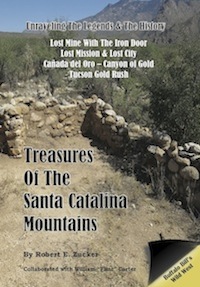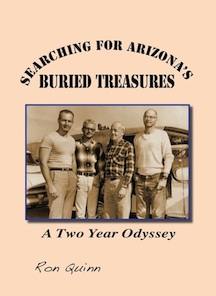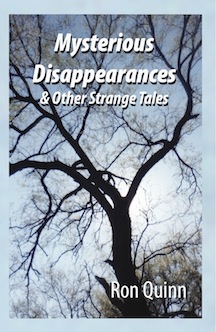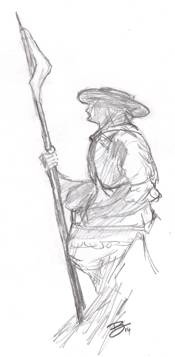The Tucson Chronicles: Volume 1, Number 1: Page 3 Historical events helped spawn the legends of the Santa Catalina Mountains.These stories are from the book “Treasures of the Santa Catalina Mountains.” To read more about these event Searching for the Treasures of the Santa CatalinasThe Lost Spanish Mission Of Santa CatalinaThe Lost Mission of the Santa Catalinas has been uncov- ered among historical docu- ments. This Spanish visita, or missionary outpost, was named by Father Eusebio Kino in 1697– the same year that local Indians reported a rich mineral deposit in the area. In 1702, Father Kino wrote that within the sight of a mission, a mining camp is often nearby. Originally, the Santa Catalina mission was lo- cated near Picacho Peak, some 30 miles west of the Catalina Mountains. But, in 1732, several priests wrote a letter, co-signed by Capt. Juan Bautista De Anza, that stated the Santa Catalina mission was “seven leagues to the east” of the San Augustin mission. That would place it somewhere along the Cañada del Oro and in the vicinity of the fabled Iron Door Mine. Read the entire story of early Spanish interests in mining and the Lost Santa Catalina Mission starting on page 77 in “Treasures of the Santa Catalina Mountains.” “Gold placering in Cañada del Oro (“gold gulch”) was undertaken in the northern Santa Catalina Mountains by Spaniards as early as the mid-1700’s.” From “Mineral Appraisal of Coronado National Forest,” 1984. Source of statement attributed to Edgar Heylmun. First ‘recorded’ Gold in The CDO(June 29, 1843 - Tucson) Spanish Colonel Antonio Narbona reported to have found gold nuggets in the Cañada del Oro, according to historian Donald Page. Read page 212 for more on this alleged historical event. Gold in Southern Arizona!(1855 - Tucson, A.T.) Immense mineral wealth has been found in the new Territory of Arizona, according to prominent scholar Sylvester Mowry. Old Spanish maps and documents provided by the Mexican government were detailed in a widely circulated report that helped spur the Tucson Gold Rush. Read how the legends developed starting on page 79. Civilizing The Cañon Of Gold(March 31, 1859 - Tucson, A.T.) To protect prospectors from hostile Indians, U.S. troops sealed the “Treaty of Cañon del Oro.” Peace didn’t last long. In 1861, John Page and Alf Scott were ambushed as their wagon trail passed through the Cañon. After more treaties, a temporary Army camp was set up in the Cañon, yet another famous massacre of Messrs. Kennedy and Israel occurred. Read all of the stories about Indian aggressions and more beginning on page 216. “And yet– those who look for it still find “color” in the Cañada del Oro. Romance and adventure still lives in the Cañon of Gold. The treasures of life are not all hidden in a lost mine behind an iron door.” from “THE MINE WITH THE IRON DOOR” by Harold Bell Wright The “Iron Door Mine” Book and Movies(1923 - Tucson) The fabled Mine with the Iron Door was known among Americans decades before it was popularized by Harold Bell Wright’s 1923 novel of the same name. Since then, several movies and books have spun off the theme of the lost mine and treasure. The original “Mine with the Iron Door” film, based on Wright’s book, and filmed in Oracle, was released in 1924 as a silent film. The theme was recreated in several other full-length motion pictures, such as “Mc Kenna’s Gold” and “Treasure of Secret Mountain.” Although the original Iron Door movie and its spin-offs did much to romanticize the lost mine theme, two prospectors from 1880 had actually pioneered the American-version of the legend. Read more about “The Mine With The Iron Door” book and films on page 179. Goldberg’s “Lost Ledge Of Gold”(1867 - Tucson, A.T.) Pioneer businessman Isaac Goldberg was one of the first Americans to explore the Catalina Mountains. His group found a mine and a copper ledge, but failed to note its location. He spent the next two decades searching for his lost ledge. In 1874, he helped form the first gold mining company in the Cañon del Oro. Read his story on page 177 in “Treasures of the Santa Catalina Mountains.” The Iron Door Mine is Found!(March 4, 1880 - Tucson, A.T.) The most famous story about the Iron Door Mine, published in the local Tucson newspaper in early 1880, told about ruins and a lost mine that were discovered by two prospectors deep within the Santa Catarina Mountains. These ruins were part of the hunt for the fabled Nueva Mia Ciudad, the Nine Mile City. The story was familiar and “probably all of the old Arizonans in the vicinity have heard the tradition of the Santa Catarinas.” They spent three days searching until they found the “mine with the iron door.” According to one of the prospectors the “old door was eaten off by rust and the iron bars that secured it were lying down at the mouth of the tunnel.” After they entered the tunnel, they saw a vein about ten inches wide. They followed it for about four hundred feet until they came upon an iron object that resem- bled a pick. They struck it against the mineral vein and “the gold rolled down in nuggets on the floor.” The newspaper reporter witnessed one hundred pounds of silver and gold that the miners displayed. Read the full account starting on page 169. Charlie Brown and The Iron Door(July 1899 - Tucson, A.T.) Downtown Congress Hall Saloon owner Charles O. Brown was a staunch believ- er in the Iron Door Mine legend. He reportedly spent $60,000 in mining operations, made repeated trips into the mountains, and kept a large mineral cabinet on display at his saloon. Read his story on page 177. McKee’s Seek The Iron Door Mine(Dec. 1932 - Tucson, AZ) Brothers Charles and Harry McKee sought the ”fabulous Escalante Mine or more properly the Iron Door Mine.” An old Indian guide showed them an old mine in the Catalinas. Word got back to Tucson that they found the fabled mine. Charles spent the rest of his life working claims in the Catalinas. See page 186 for more about the McKee’s treasure hunt. Treasures Discovered in Catalinas(Circa 1915 - Tucson, A.T.) A discovery of several Je- suit treasure chests and jewels in the Catalinas was found in a cave near Apache Peak south of Old Hat District by local rancher Sistro Castro in 1915. An Or- acle couple also told a story about the father and the uncle of Ernesto Castro (Severiano) who discovered a large nugget of gold plus numerous grains. They sold the nugget for $45,000. Read more on page 320.
|
 |
Entertaining Tucson Across the Decades |  |
Treasures of the Catalinas |
 |
Searching for Arizona's Buried Treasures | 
|
Traveling Show |
 |
Mysterious Disappearances |
Tucson Chronicles will soon feature upcoming print and web editions of "Entertaining Tucson Across the Decades," a recent book also by author Robert Zucker with hundreds of articles and interviews from the 1980s published in the Entertainment Magazine and Newsreal newspapers. The first edition covers the 1950s through 1985.
 s, see the noted page numbers of the book. Download a free sample PDF of the book.
s, see the noted page numbers of the book. Download a free sample PDF of the book.